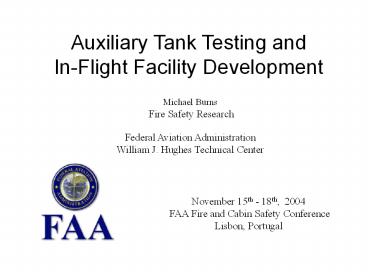Ground Based Fuel Tank Inerting PowerPoint PPT Presentation
Title: Ground Based Fuel Tank Inerting
1
Auxiliary Tank Testing and In-Flight Facility
Development
Michael Burns Fire Safety Research Federal
Aviation AdministrationWilliam J. Hughes
Technical Center
November 15th - 18th, 2004 FAA Fire and Cabin
Safety ConferenceLisbon, Portugal
2
Background
- Three major accidents involving center wing tanks
(CWT) - March 2001, Thai Airways International, Boeing
737-400 - July 1996, TWA flight 800, Boeing 747-100
- May 1990, Philippine Airlines, Boeing 737-300
- FAA seeks its flammability reduction rule since
1997 - Two unsuccessful industry rulemaking advisory
committee working groups - FAA developed a demonstration fuel tank inerting
system - Installed and operated on several test transport
aircraft - Uses air separation modules (ASM) and a dual /
variable flow methodology - Unique methodology allowed for simple,
lightweight, reliable onboard nitrogen generation
3
Center Wing Tank Inerting Research
- Recent CWT testing with NASA, Airbus and The
Boeing Company - FY01- FY04 testing and validation of CWT inerting
methodology - In-flight measurement of fuel tank flammability
- Excellent results but little work has been done
to study the affect of auxiliary tank operations
on CWT - New research facility at FAA WJH Technical Center
- Construction scheduled for winter, 2005
- Facility being designed to study fuel tank
inerting and flammability - Real-time CWT operational simulation, full-scale
testing, and model validation
4
Center Wing Tank Inerting Facility
5
Center Wing Tank Inerting Facility cont.
- Initial use to further study the affect auxiliary
fuel transfer has on an inert CWT - Ullage oxygen concentration changes due to fuel
transfer - Purge cycle effects once the auxiliary tank is
empty - Auxiliary tank refueling effects
- Facility will house a full-scale CWT and
auxiliary fuel tank - Simulate altitude as well as engine fuel burn
- Thermocouples, pressure transducers and gas
sample ports for gas analysis to allow for
testing - Measure nitrogen generating system parameters
6
Facility Overview
7
Facility Overview cont.
- Approximately 26 x 40
- Interior Communication Signal Raceways
- Pumps (3)
- Vacuum
- Hi-capacity pump with closed loop cooling system
- Capable of simulating a 40,000 foot altitude
(approx. 2 psia) - Fuel (P1) Electronically Controlled, Modulating
- Engine fuel burn simulator
- Variable frequency drive fuel flow controller
simulates taxi, take off, climb, cruise descent - Fuel flow meter with digital output
- Capable of flowing 85 GPM maximum fuel flow.
- Fuel (P2) Fixed
- Used to refuel the CWT / aux. tank when required
- Plumbed to a 10K gallon fuel vault
8
Facility Overview cont.
- Control Room
- Environmentally controlled
- Houses all the controls, analyzers, computer and
data acquisition equipment - 8 x 8, mounted on a raised concrete slab
- Safety Features
- Spill Protection Containment pit with sump
- Foundation contains curbing that is approx. 14 x
24 x 18 - Approximately 500 cubic feet of volume to contain
any accidental spillage of fuel - Fire protection
- Over pressure relief panel system
9
Facility Overview cont.
- Vacuum pump evacuates chamber
- Altitude controller
- PID Controller
- Modulating Valve
- Pressure Transducer
10
Facility Equipment 737 CWT
- Tank origin
- Salvaged from an Air Canada aircraft in March
2003 - Tank Dimensions / volume
- Approx 12 x 14 x 3 (or 500 CuFt in volume)
- Reinforcing the CWT
- Exterior bracing was applied around the tank
structure and fastened to the tank wherever
possible - Columns were installed in each bay internally to
offset compression forces exerted on the tank
while applying a vacuum
11
Facility Equipment cont. 737 CWT
12
Facility Equipment cont.737 CWT
- Vent configuration
- Internally the tank is vented in the most forward
bay as well as the aft bay - The left right vent stringer was modified with
a flange connection - These 2 connections will be joined together with
plumbing and routed to the facility vacuum system - Engine burn simulation fuel feed tubing
- Facility tubing will be tied into the fuel boost
pump feeds on the tank
13
Facility Equipment cont.737 CWT
Left Fuel Feed Tubing (Bay 3)
Right Vent Tubing (Bay 2)
14
Facility Equipment cont.Auxiliary Fuel Tank
- Tank origin
- US Airways surplus auxiliary fuel tank
- Tank Dimensions / volume
- Approx. 8 x 4 x 3
- Approx. 475 Gallons of fuel
- Single tank configuration
- Also known as a Master Fuel Cell
- Contains a dry bay that houses all the valving
associated with the system - Cabin Tube
- The fuel cell is pressurized during flight using
cabin pressure - In facility, shop air used to simulate normal
tank operation
15
Facility Equipment cont.Auxiliary Fuel Tank
16
Instrumentation 737 CWT / Auxiliary Tank
- Thermocouples
- All thermocouples are T type
- 25 total installed throughout the CWT
- 4 total installed throughout the Auxiliary Fuel
Tank - Gas sample tubes (FAS, OBOAS)
- All sample tubing is made up of PFA material and
¼ in diameter - 6 total mounted throughout the CWT
- 2 total mounted throughout the auxiliary fuel
tank - NEA Inerting Manifold
- Single injection nozzle made of PFA tubing
17
Instrumentation cont.737 CWT / Auxiliary Fuel
Tank
- CWT location of penetration fittings
- NEA
- Thermocouples
- Oxygen / FAS Sample Return Fitting
- Hi Level Float Valves
- Auxiliary Fuel Tank Transfer / Vent Flange
- Oxygen / FAS Sample Fittings (6)
18
- Instrumentation cont.737 CWT
19
Instrumentation cont.Auxiliary Fuel Tank
20
Future Work
- Facility will be a key tool for continued fuel
tank inerting and flammability research - Study the affect varying surface temperatures
have on flammability - Potential industry tool to validate new inerting
systems and methodologies - Use facility to validate a variety of models for
studying fuel tank inerting and flammability

